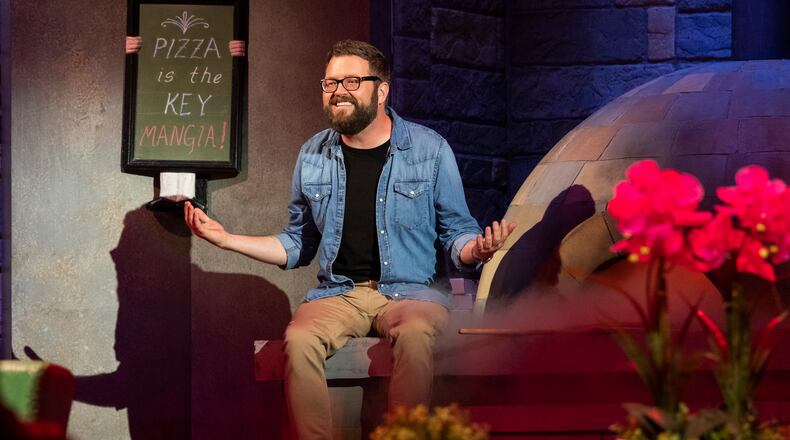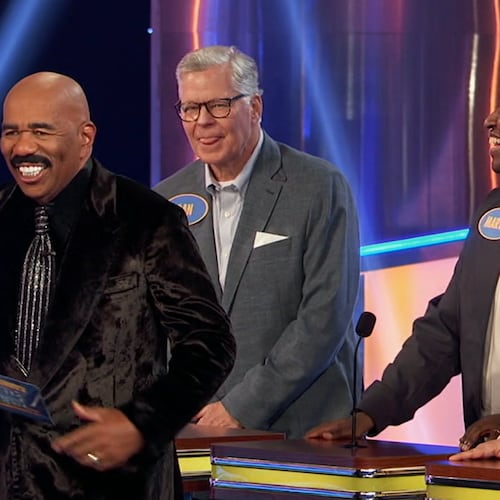The No. 1 show on Netflix for five days running has been an absurdly escapist competition show called “Floor Is Lava” featuring Peachtree City resident Rutledge Wood as the wise-cracking host.
“It’s crazy, totally unexpected,” said Irad Eyal, an executive producer.
This program — based on the childhood game of the same name — has become a scorching hot alternative to all the depressing news happening in the real world. It’s a mélange of “Wipeout,” an escape room and parkour.
In most of the 10 episodes, three teams of three players have to traverse objects to reach an exit, while avoiding the fateful drop into the “lava.” Depending on the room, there are tables, beds, pyramids, pizza ovens and rockets.
The team who gets the most players to the exit in the shortest amount of time pockets $10,000 and a $29 lava lamp. (It’s split among three people and after taxes, this is not life-changing cash but the experience is clearly one of a kind.)
The idea of the show came from Megan McGrath, vice president of development for the production company Haymaker Media.
“She had played this game and posted it on YouTube,” Eyal said. “She brought it up. We thought we would like a great stoner game. Then we thought we could super size it and tap into our imagination.”
Last year, they built a massive pool in a warehouse in Burbank, California, filled it with 80,000 gallons of red “lava” and created set pieces above the liquid. Season one featured five themed rooms including a planetarium, a study and a kitchen. “We had dozens of ideas,” he said, which could be used in future seasons if Netflix is so kind to bestow them with more.
To win takes some combination of luck, teamwork, strategy, balance and strength.
But unlike, say, “Titan Games” or “American Ninja Warrior,” you don’t necessarily need to be the most athletic crew to take home the prize. “Some people who won were families,” Eyal said. “They just thought carefully about the course.”
The show also needed a host and knew Wood from his hosting gig on another Netflix competition show "Hyperdrive," which was shot in Atlanta in 2018.
“We loved his sense of humor,” Eyal said. “He can do funny commentary. He wrote a lot of his own material. He was able to translate the ridiculousness in a way that would appeal to kids and have some jokes for the adults.”
Wood was proud of his heavy use of puns. While one player was trying to climb across a hanging pot rack, monkey bar style, pans kept hitting him in the face. So Wood said, “Todd succeeded, although some say he got panned. Some, not me. I wouldn’t pander like that. Ooh, it hurts, doesn’t it?”
He admitted he “really jumped into the dad joke well. I was trying to channel my buddy Rob Riggle and my dad at the same time.”
Each team was given a “sell point.” There were three Black female gamers. There were three college buds dubbed “Party Animals.” There were teams of doctors, nurses, firefighters and flight attendants.
Some teams played up their characterizations with stereotypical glee. For instance, a trio of Bostonians were comically arrogant.
When they see the "planetarium" set which featured planets, Chris immediately said: "Where are all the rings on the planets? Oh, that's right. Tom Brady's fingers! Whooo!"
Wood:" Amazing! The Bostonians were able to last almost five seconds before mentioning Tom Brady!"
Wood kept at it, comparing the lava to clam chowder, uttering “How ‘bout ‘dem apples?” from “Good Will Hunting” and cracking jokes about Larry Bird and the Charles River. When one of the players jumped on a rocket, Wood exclaimed: “wicked awesome and wicked painful. He landed on his Boston baked beans!”
He recalls playing “Floor Is Lava” in the basement of his parents’ home in Birmingham, Alabama. “We had so little furniture,” he said. “I remember standing on the coffee table and throwing a hat on the ground, trying to jump on it and make it to the stairs.”
He now plays the game with his own daughters, ages 6 to 11, who have already binged the first season three times over since last Friday.
“They just think it’s hilarious,” he said. “As a dad, it makes me feel so proud and so happy.”
His kids especially loved a parody song he sang episode 10 based on the Miley Cyrus song “Wrecking Ball.”
The producers also revel when someone “drowns” in the lava. Often, they will replay the drop multiple times from multiple angles.
One thing they are keeping secret is the nature of the “lava” itself. They won’t describe its viscosity, its temperature or even how deep it goes. Players, when they fall in, don’t flail about but appear to be told to “sink” down as if they are immediately “burned.”
We never see the players pulled out of the lava. It’s part of the theater of the game itself.
And Wood sells the lava like a pro: “It’s menacing and bubbly and red and scary.”
About the Author
Keep Reading
The Latest
Featured





